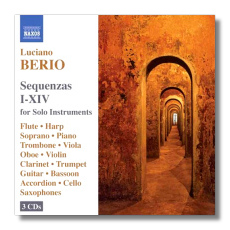
The Internet's Premier Classical Music Source
Related Links
- Berio Reviews
- Latest Reviews
- More Reviews
-
By Composer
-
Collections
DVD & Blu-ray
Books
Concert Reviews
Articles/Interviews
Software
Audio
Search Amazon
Recommended Links
Site News
 CD Review
CD Review
Luciano Berio

Sequenzas I – XIV
- Sequenza I for Flute (1958) - Nora Shulman, flute
- Sequenza II for Harp (1963) - Erica Goodman, harp
- Sequenza III for Female Voice (1966) - Tony Arnold, soprano
- Sequenza IV for Piano (1966) - Boris Berman, piano
- Sequenza V for Trombone (1966) - Alain Trudel, trombone
- Sequenza VI for Viola (1967) - Steven Dann, viola
- Sequenza VII for Oboe (1969) - Matej Sarc, oboe
- Sequenza VIII for Violin (1976) - Jasper Wood, violin
- Sequenza IX for Clarinet (1980) - Joaquín Valdepeñas, clarinet
- Sequenza X for Trumpet and "silent" Piano (1984) - Guy Few, trumpet
- Sequenza XI for Guitar (1988) - Pablo Sáinz Villegas, guitar
- Sequenza XII for Bassoon (1995) - Kenneth Munday, bassoon
- Sequenza XIII for Accordion (1995) - Joseph Petric, accordion
- Sequenza XIV for Cello (2002) - Darrett Adkins, cello
- Sequenza VIIb for Soprano Saxophone (1995) - Wallace Halladay, soprano saxophone
- Sequenza IXb for Alto Saxophone (1981) - Wallace Halladay, alto saxophone
Naxos 8.557661-63 3CDs: 63:02, 60:09, 58:48
In 1999 Deutsche Grammophon released a three-CD set that contained most of Luciano Berio's Sequenzas. It lacked Sequenza VIIb and Sequenza XIV, for cello, the last piece in the series, which the composer wrote in 2002, as indicated in the headnote. There are sixteen Sequenzas in all, fourteen bearing their chronologically-assigned Roman numeral and two, arrangements of VII and IX respectively, carrying their appropriate Roman numeral followed by a 'b'. Recently, the label Mode released a recording containing all the works in the series, and now Naxos has entered the Sequenza sweepstakes with this three-CD set. I have not heard the Mode CDs (which have generally received positive reviews), but do own, and have reviewed the DG set, which I found quite convincing.
The Naxos offering here has the advantage of being the least costly of the three by far, and it, like the Mode set, contains all sixteen works in the series. The performances on DG and Naxos are both splendid, and their sonics are full-bodied and vivid. Berio apparently influenced some of the choices of players on the Mode set, with two of the dedicatees appearing, cellist Rohan de Saram and trombonist Stuart Dempster. Also, the composer wrote the notes for the DG set and thus tacitly, it would seem, approved of the offerings in that pioneering effort.
But if Naxos lacks the imprimatur of the composer (he died in 2003), it contains the authority of high art. These are excellent performances of Berio's difficult music – music not just challenging for the player, but for the listener as well. Notable here are the efforts turned in by harpist Erica Goodman, soprano Tony Arnold, clarinetist Joaquín Valdepeñas, guitarist Pablo Sáinz Villegas, and bassoonist Ken Munday.
I made several A-B comparisons between the DG and Naxos sets and must conclude that performers on both are excellent, with no one sounding less than compelling in the series. But, again, the Naxos is complete and comparatively cheap alongside the competition. For Berio enthusiasts all sets of this strangely intriguing music are essential, but to those adventurous listeners wanting to sample this collection in a single set, the Naxos would be the easy choice.
Copyright © 2006, Robert Cummings




















